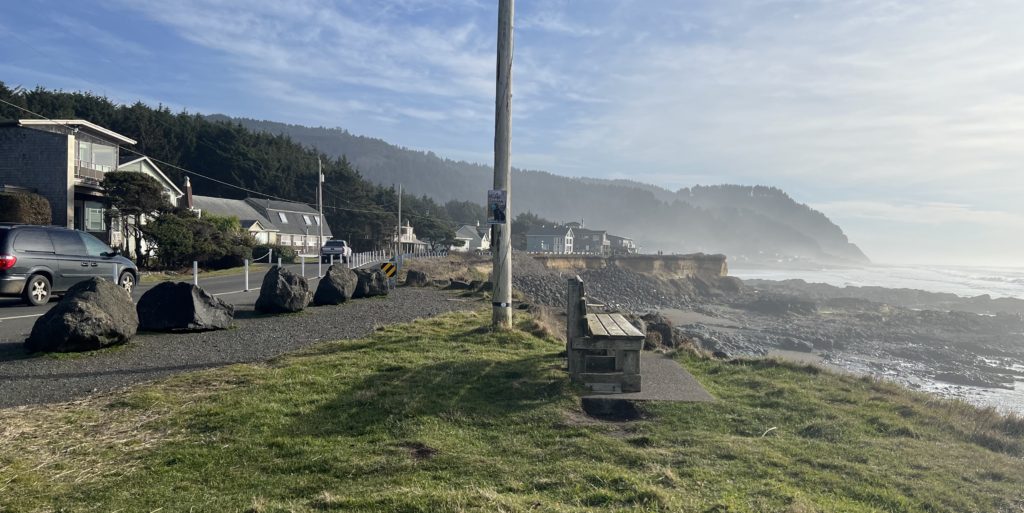
By KENNETH LIPP/YachatsNews
YACHATS — The city of Yachats is one easement away from taking ownership of Ocean View Drive, the final obstacle to finishing a series of pocket parks and breaking ground on a $1 million boardwalk.
But a prolonged city council discussion last week of an insurance agent’s visit to the parks also turned into a tussle among council members regarding the project’s oversight by the city manager.
The city is awaiting transfer of the last portion of Ocean View and Marine drives and adjacent rights-of-way as part of the 18-year-old 804 Trail settlement agreement with Lincoln County, several organizations and property owners. In 2017, the city resumed negotiations with the county, which was to obtain property and necessary easements, ensure the road was up to standards, make trail improvements and fulfill various other requirements.
During the first two years of the Covid pandemic, the Yachats Parks & Commons Commission made significant progress with planning, design and funding for several projects, including two small “pocket parks” on the west side of Ocean View. The pedestrian waysides would serve as spots to rest and take in the dramatic ocean views.
In October 2021, the city council approved $25,000 for pocket parks in two approximately 1,200-square-foot unimproved areas across from Fourth and Sixth streets. With working titles of North and South Sunset, the park areas are already protected from vehicle traffic by delineators separating the 804 Trail from the driving area, new guardrails and large boulders.
The proposal from the Parks & Commons Commission and other volunteers moves and adds benches, cut paths through grasses and salal to new sitting areas, scrapes off or levels areas of gravel, installs warning signs and plants native flora.
The commission — with council approval — got as far as purchasing $3,000 worth of plants. But its progress hit a snag when plans reached an understaffed city hall and unfilled requirements such as an archaeological review of the sites and final easements. Unable to enhance property they don’t own, the commission put the plants in storage.
City manager Heide Lambert said the county has obtained two easements in the past six months — the city is responsible for sending letters seeking the easements — and has one more to get before the county can relinquish its ownership of Ocean View. Then the city can move forward with the pocket parks and, eventually, a 350-foot-long boardwalk overlooking the Yachats River.
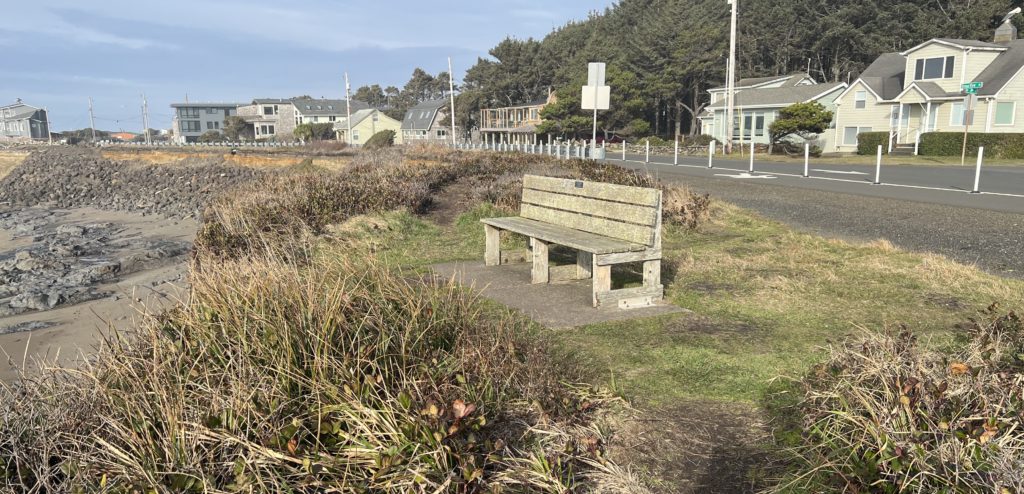
Risk assessment
Lambert asked the city’s insurance company to evaluate all three parks for potential safety hazards. Some of its recommendations, delivered to the city council last week, mirror or are similar to existing plans.
While the project appears poised to finally move forward, tensions still arose about the subject among councilors, two of whom served on the Parks & Commons Commission before joining the council in January. On Wednesday, they expressed frustration with the insurance agency’s report and delays in the process. Moving forward with the parks is among the new mayor Craig Berdie’s goals.
The subject matter also highlighted an increasingly apparent conflict of philosophy among councilors about how to supervise their city manager.
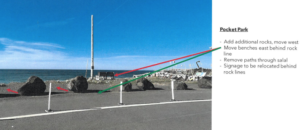
During its regular meeting Wednesday, the council heard recommendations from its insurance company for the layout of the pocket parks and the existing Peace Park a bit farther north. Katie Durfee, risk management supervisor for Citycounty Insurance Services, visited the parks along with city staff on Jan. 20. She suggested the city implement measures to discourage visitors from approaching the cliff and from using apparent trails as beach access, as they lead to dangerous rocks.
Recommendations at all three parks are essentially the same — place a line of boulders farther west; move west-facing benches east next to the trail; and install signs on the west side of the boulders facing east warning of hazardous terrain, potential exposure to sneaker waves and signs on trails warning that beach access is “at your own risk.”
Durfee said beach access warning signs are needed because paths that spur from the main viewpoint are treacherous.
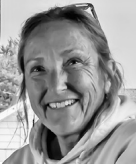
“With all due respect, I think unfortunately in your visit there may have been gross misguiding,” said councilor Catherine Whitten-Carey, who served on the Parks and Commons Commission. “Claiming that (people are) clamoring down the rocks, or paths, is not the case, people do that, but it’s not a real path. The handrail you described is actually a broken steel tether from a utility pole and you can see the other half hanging in the wind,” she said, referring to recommendations regarding North Sunset in Durfee’s written report.
Whitten-Carey said there are people in Yachats who have worked on the parks for years “in terms of their dreams and their plans for them,” and she asked why there wasn’t representation from the parks commission during the consultant’s on-site review.
“That would have informed this visit much better,” Whitten-Carey said.
Durfee said she would be willing to return. She added that she knew it was not an actual handrail but believed the guy wire at North Sunset was being used to climb over the rocks. And even if the pathways are not formal trails, people unfamiliar with the area might believe they are and not realize hazardous conditions await them below.
“I felt that there were just some really easy ways that you could limit exposure,” Durfee said. “There’s some erosion on the cliffside next to it, and bringing that park bench back next to the trail would discourage people from getting close to the cliff edge.”
She noted her company did not provide liability coverage where city property ends and where Oregon State Parks’ jurisdiction begins.
Councilor Greg Scott said the city has relied on immunity from liability based on the free status of all trails all over town.
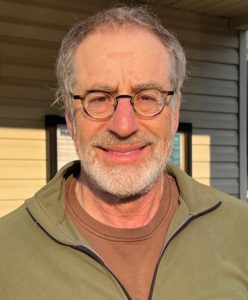
Berdie, who chaired the Parks and Commons Commission when it devised the pocket parks plan, noted it already intended to move the benches farther east, although not so close to the path.
“Just, somebody walking down the trail sitting on the bench and you get slapped in the back of the head,” he said. “I’d rather have it a few feet in so there’s a little privacy there.”
Lambert said she believed the main difference between Durfee’s recommendations and the commission plan was the relative positions of signs, benches and boulders, the former aiming to corral visitors toward the paved pathway.
Scott said the original reasoning behind placing boulders at the park was to keep vehicles off the trail, and he scoffed at the idea of the approximately 3-foot rocks deterring people on foot.
“What we want to discourage is people going into that area close to where the cliff is eroding,” Durfee said.
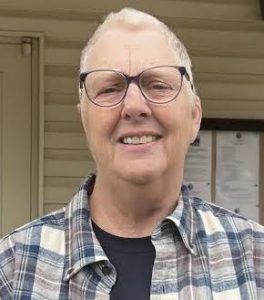
Councilor Ann Stott said she thought the proposed arrangement was reasonable, with some adjustments, such as smaller boulders between the bench and the cliff to maintain the view.
“I think if we take this and we mold it with what we’re doing, we’re on the right track,” Stott said. “They make good recommendations.”
Berdie said he agreed the recommendations had merit and suggested sending them to the commission to modify the plan.
Stott pointed out that the parks have never been formally named. Drawing on an element of Durfee’s report — that calling them parks would have the effect of attracting people there as a destination — she repeated a suggestion she said she made to the Parks and Commons Commission that was not well received at the time.
“What if we call the whole thing something like ‘Sunset Walkway,’” she asked. “Instead of identifying this pocket here, this pocket here.”
“Hopefully this clears the air”
At the end of the meeting, Berdie again raised the issue of the Ocean View easements, asking if any city councilors had oversight in the process.
“Until the county hands it over, we’re basically in waiting mode,” Scott said.
“We do the distributions of easements,” Lambert said, adding they’ve completed two since August. “We’re waiting on one easement.”
She said county commission chair Kaety Jacobson told her the city is “so close” to completing the process.
“My question is, does any elected official have any idea what we’re talking about, and should we,” Berdie said.
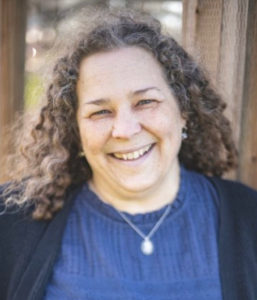
Lambert replied that it was an administrative duty.
“I agree that it’s an administrative duty, but there’s an oversight responsibility that any elected body has over the administration, and it’s not to interfere,” the mayor said.
Lambert said she’d invited Berdie to her office to discuss the matter, and that she was sensing a distrust from him and another councilor that she did not understand.
Berdie said Lambert previously told him he needed a vote of the council to get the information. Lambert replied that she said Berdie would need a vote to have the administrative oversight he sought. Berdie told her he misspoke.
“I have made more progress on this road than has happened in five years, and for some reason you’re asking to have more oversight of me, and I don’t understand what that is,” Lambert said.
Berdie said he thought it was appropriate to understand the details of what an employee is doing.

“Let’s back up,” Scott interjected. “The oversight body is the council. So if you want to make a motion along this line, we can vote on it right now.”
Berdie made a motion: That at least one and no more than two members of council “have access to the written communications regarding easements for Ocean View Drive.” He and Whitten-Carey voted yes; and Scott, Stott and councilor Mary Ellen O’Shaughnessey voted no.
“Hopefully that clears the air,” Scott said.
- Kenneth Lipp is YachatsNews’ full-time reporter and can be reached at KenLipp@YachatsNews.com



As a fairly new resident of Yachats, I am trying to understand how the city government works. I believe the city manager is hired to follow through with actions determined necessary by the city’s elected officials. In following YachatsNews, it sounds like the city manager is confused by her role and perhaps needs her job description more clearly defined.
There’s a balance between the city council overstepping and overseeing the mechanisms of city management. Seems to me like the city manager is feeling sensitive about a reasonable and responsible request made by the mayor. She’s new and he’s new, so it’s to be expected that there would and should be interest in clarity. The city manager will increase the trust of the council and of citizens by being more open to that. That said, our city manager’s autonomy is to be supported if members of the council begin micro-managing where they clearly shouldn’t. This wasn’t one of this times.
“I have made more progress on this road than has happened in five years, and for some reason you’re asking to have more oversight of me, and I don’t understand what that is,” Lambert said.
This is insulting to the numerous people who have put a great deal of time, energy, and attention to the the development and transfer of Oceanview Drive.
I question whether someone who says something like this has put in the time to understand the situation fully.
To understand this issue, it is important to know that paved road do not always follow the right of way in all areas so some pavement is on private property. This usually occurs on older roads where record keeping was less accurate. Since Lincoln County owns the road, they have to negotiate with property owners where easement problems exist. In most cases, property owners are being asked to give up part of their land and this can require negotiations between the county and property owner. Yachats officials have to wait until all easement issues are resolved before the transfer from the county to the city can be completed.
The city manager is the appropriate individual to represent the city in these discussions and keep the council informed about progress. During the last council meeting, the mayor indicated that he wanted council oversight of the city manager’s efforts about this topic.
There are three regulatory areas that define the role of the city manager and the council. The highest authority is the voter approved City Charter. The other two are the municipal code and administrative policies. The charter functions as the city equivalent of our constitution. The charter defines the city manager and council authority very clearly. The only way a council member can engage in an administrative oversight role is with the approval of a majority of the council. Outside the role of setting the council agenda and running a council meeting, the mayor’s authority is the same as a council member.
Decision making for government is very different than it is for businesses. It isn’t uncommon for a new council member to spend their first year learning about new terminology and processes the city has to follow. I do not believe this is the case here. The discussion at the end of the last meeting is more about a difference in opinions about how to interpret the charter’s restrictions on the council’s involvement in administrative affairs. The vote indicates that a majority of the council believes the city manager’s authority for negotiations with the county are outside the scope of individual council oversight. The city manager’s comment was related to clarification from the council about administrative authority. It was not about the road or any desired or needed changes in the path.
“The charter functions as the city equivalent of our constitution. The charter defines the city manager and council authority very clearly. The only way a council member can engage in an administrative oversight role is with the approval of a majority of the council. Outside the role of setting the council agenda and running a council meeting, the mayor’s authority is the same as a council member.”
Having not only served on the Council that passed the City Charter reform amendment that institutionalized the city manager position in the document in the first place, but having also personally worked on this language, I don’t believe it says that in the City Charter. I’m open to being shown where in the City Charter it says this and conceding that I am mistaken.
In the administrative policy you alluded to, however, it clearly says:
“[The] Mayor, Council President act as first-line supervisors to City Manager.”
This is from an official document on the City website. That seems pretty clear.
It would be disadvantageous to the citizens of Yachats for the Council to engage in a pattern of apathy when it comes to supervising the City Manager. As was said earlier, it’s about creating a healthy balance between supervision and overstepping. Such a balance is established when the council and our (still new) city manager gets to know each other’s strengths and areas of growth. That seemed to me to be the spirit of the Mayor’s request. The idea isn’t to create gotcha moments, but to create ‘we got this’ together wins where we’re all pulling together from different angles perhaps toward common goals.
Ditch the “pocket park”, the boulders and the dumb delineators and return parking to ocean view lookout. It’s not much of a park 80 percent of the year due to weather anyways.
Re: Proposed 350-ft. boardwalk purpose~
Parking? Do people [who don’t live nearby or pay by the night to be in Yachats] park at the State Park and take a leisurely stroll east on the boardwalk, then cross the street at the dangerous curve on 101, a commercial interstate highway, to enjoy the businesses on Hwy101? Reversing the route takes pedestrians across 101 via crosswalks in “downtown” Yachats, which is safer, but eventually, there might need to be a crosswalk at the dangerous curve. Is there enough parking at the State Park and elsewhere in Yachats to accommodate these foot-traffic scenarios? Please keep in mind, everything needs to be alter-abled accessible, including the appropriate number of handicap parking spaces.
Suggestion: Consider a see-through marine-grade steel grate walkway suspended on trusses and steel columns. Advantages~ it might be lighter weight. It might be less invasive to the natural landscape. Especially less invasive visually. If designed in a certain way, when viewed from across the bay, it would look like people “floating” off the edge of the cliff instead of seeing yet more man-made concrete blobs defacing natural beauty. The walkway could curve gently out and down slightly from the edge of the land to create a somewhat “immersive” experience, and help separate pedestrians from the highway traffic. Use unobtrusive signage. If future changes need to be made due to changes in the cliff itself, or changes in traffic patterns, it would be easier to change steel-grate sections than concrete blobs.
Scroll all the way down this page link to see how the concept could be modified and scaled down for use in Yachats: Here’s spray in yer eyes!
https://mustdonewzealand.co.nz/tours/treetop-walk-cafe-hokitika-west-coast/
Instead of moving the benches back, can’t you just put some type of fencing in front of it?
If a party identifies a ‘risk’, and that party takes steps to reduce that ‘risk’ (placing boulders, fence, etc.,) that party assumes the liability. However, left in it’s natural state, liability is arguable. Look south at how the State of Oregon handles the issue.
Take this opportunity to use the sites to inform the public on the geology, erosion, wave action. What an opportunity.
I agree with Norge — situations like this exist up and down the coast of Oregon as well as the coasts of Washington and California. There must be ample precedent for dealing with this kind of situation. I think it would be smarter to learn from how others address the situation rather than starting from scratch. This strikes me as “reinventing the wheel” and coming up with a version that is not as good as the original. Perhaps, a field trip to Cape Perpetua is in order.
This is all over-management of a natural setting. Yank the delineators, which are among the worst eyesores on the coast and a huge wasted expenditure. The most needed here is “caution” “stay back” signs, used up and down the west coast. People use boulders and stumps to sit on as well as benches. Back off, controlling anal humans. Don’t allow yourselves to live constantly in fear of what might happen. Someday, if i want to end it all, I might just sail off from one of these spots no matter where the bench is positioned.